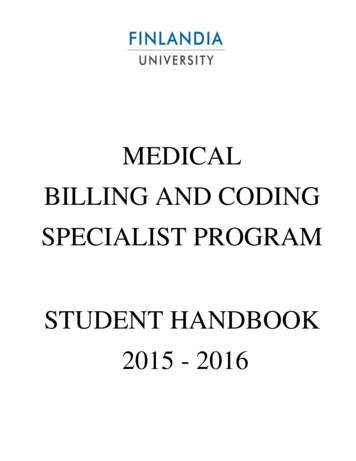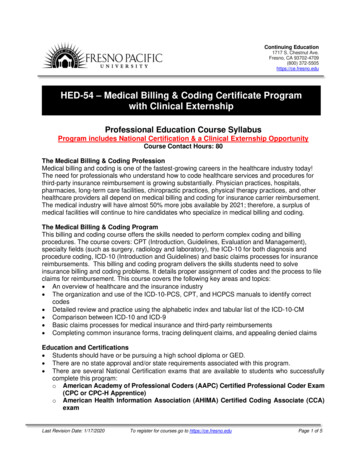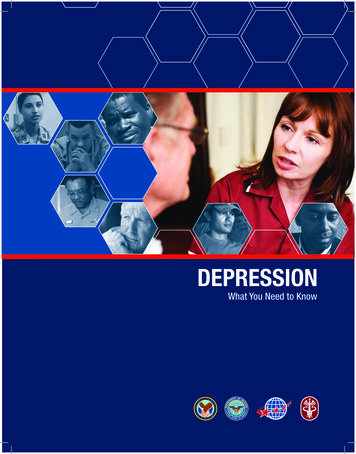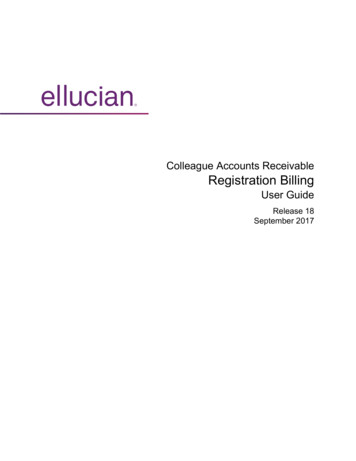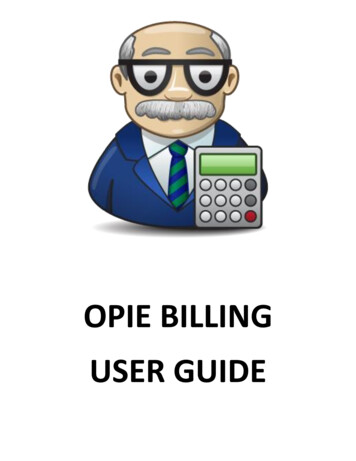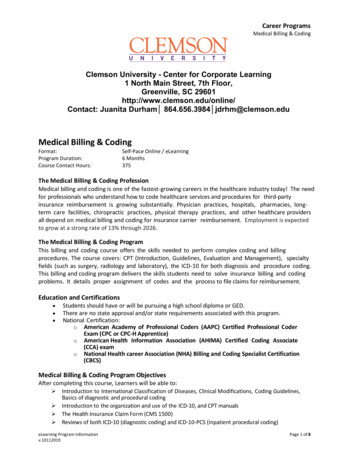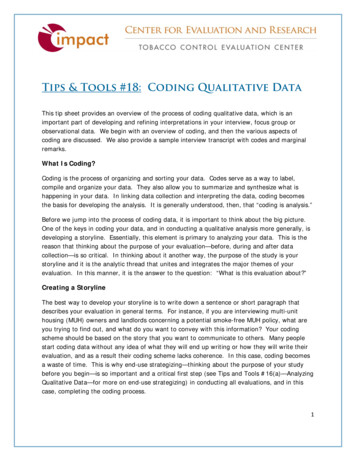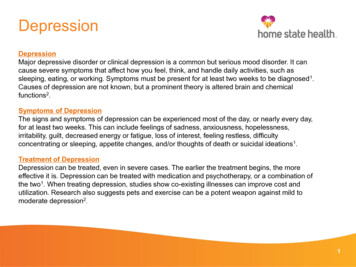
Transcription
DepressionDepressionMajor depressive disorder or clinical depression is a common but serious mood disorder. It cancause severe symptoms that affect how you feel, think, and handle daily activities, such assleeping, eating, or working. Symptoms must be present for at least two weeks to be diagnosed1.Causes of depression are not known, but a prominent theory is altered brain and chemicalfunctions2.Symptoms of DepressionThe signs and symptoms of depression can be experienced most of the day, or nearly every day,for at least two weeks. This can include feelings of sadness, anxiousness, hopelessness,irritability, guilt, decreased energy or fatigue, loss of interest, feeling restless, difficultyconcentrating or sleeping, appetite changes, and/or thoughts of death or suicidal ideations1.Treatment of DepressionDepression can be treated, even in severe cases. The earlier the treatment begins, the moreeffective it is. Depression can be treated with medication and psychotherapy, or a combination ofthe two1. When treating depression, studies show co-existing illnesses can improve cost andutilization. Research also suggests pets and exercise can be a potent weapon against mild tomoderate depression2.1
DepressionGoalTo provide coding and risk adjustment education including documentation on specificity of the disease andenhance the awareness of related HEDIS measures. Encourage open discussions between coder/provider.AudienceBillers, Coders, Providers, including but not limited to Nurse Practitioners, Physician Assistants, GeneralPractitioners, Family Medicine, Internal Medicine, Therapists, Master Level Providers, Psychologists, andPsychiatrists.Resources1. National Institute of Mental Health: Bipolar Disorder (revised February sion/index.shtml2. WebMD Depression: What Is It? (reviewed July 3, 2018) sion-overview3. 2019 ICD-10-CM Expert for Physicians: The Complete Official Code Set, Optum360. 2018 Optum360 LLC4. PHQ Screeners: Depression Screening; Kroenke K, Spitzer RL, Psychiatric Annuals 20002; /g10016261/f/201412/PHQ-9 English.pdf5. HEDIS 2019 Technical Specification for Health Plans6. US Preventive Services Task Force; t our tools-resources/coding-page.html2
Depression Coding GuidanceTIPS:ICD-10- Mapping & Education ICD-10-CM- -F32.0 – F33.9 (Major depressive disorder) Attempt for morespecificity Avoid broad terms and unspecified codes such as “Depression”, F32.9 (ICD 10 CM code) Be thorough in picking up the details in documentation This can lead to a better understanding of the depression and assist with accurate coding Remember to code out other mood affective disorders, such as, Manic (F30.-) and Bipolar (F31.-) In the documentation useterms that specify Severity Mild Moderate SevereEpisodes Single Recurrent In Remission, partial or full Depression ScreeningTool Refilling medication HEDIS 2019 US Preventive ServicesTask Force PHQ-9 is a nine question instrument for patients to complete in a primary care setting to screen for thepresence and severity of depression. The results are used to assist the provider in making a depressiondiagnosis including the severity. Note all disclaimers on the website Visit 1/f/201412/PHQ-9 English.pdfVerify depression is documented in the note and that it is listed and addressed in the Assessment & Plan,noting status and any medication changes.The percentage of members 18 years of age and older who were treated with antidepressant medication,had a diagnosis of major depression and who remained on an antidepressant medication treatment.There are 2 rates reported for this measure: Acute Phase Treatment: The percentage of members who remained on an antidepressantmedication for at least 84 days (12 weeks). Continuation Phase Treatment: The percentage of members who remained on an antidepressantmedication for at least 180 days (6 months) 5.Recommend screening all patients over the age of 12 for depression at every visit or at a standardinterval) 6.3
PHQ 9 Questionnaire for Depression ScreeningAfter member has completed the screening, count the number of boxes checked in each of thecolumns. Take the number and multiply by the value indicated below. Add the subtotals of each toproduce the total score. Range is from 0 – 49256/f/201412/PHQ-9 English.pdfNot at allSeveral daysMore than half of the daysNearly every dayTotal scoreDiagnosisScoreNo or Minimaldepression0–4Mild depression5–9For Score 410 – 14Moderately severedepression15 – 19Severe depression20 – 27Proposed Actions- ICD-10-CMSuggests the patient may not need depressiontreatmentNot applicableF32.0 or F33.05 – 14Moderate depression(#) x 0 (#) x 1 (#) x 2 (#) x 3 14Clinical judgement should be used for treatment,based on the duration of symptoms and functionalimpairmentDepression should be treated, using antidepressant,psychotherapy and or a combination of treatmentF32.1 or F33.1F32.1 or F33.1 (moderate)F32.3 or F32.3 (severe)F32.2 or F33.2 (w/o psychoticfeatures)F32.3 or F33.3 (w/ psychoticfeatures)In Partial RemissionIf member has been previously diagnosed with depression (regardless of severity),document that the depression is “in partial remission” in the note.DSM 5 defines partial remission as patient has some symptoms but not meeting fullcriteria for the last 12 months.F32.4 or F33.41In Full RemissionIf member has been previously diagnosed with depression (regardless of severity),document that the depression is “in full remission” in the note.DSM 5 defines full remission as patient has no symptoms for the last 12months.F32.5 or F33.421/30/20194
Billing Sample #1Primary Care Physician Documentation: Medical record SOAP format (condensed)DOS: 04/14/2018Gender: F DOB: XX/XX/1966 Pulse: 69 Temp:98.7 F B/P:142/86 Weight: 130lb Height: 5.6 BMI: 21HPI: A 52 y.o. female with a history of hypertension and Fedeficiency anemia. Here today for routine follow-up. Patient alsocomplains of decreased interest in things she used to enjoy;experiencing decreased energy, concentration and poor appetite.She is having some family issues with son and his wife.PHQ 9 Assessment: (Included positive questions)Little interest or pleasure in doing things? (score 2)More than halfthe daysFeeling down, depressed, or hopeless? (score 1) Several daysFeeling tired or having little energy? (score 1) Several daysTrouble concentrating on things, such as reading the newspaper orwatching television? (score 1) Several daysNot at allSeveral daysMore than half of the daysNearly every day(#) x 0 (#) 3 x 1 3(#) 1 x 2 2(#) x 3 Total score 5Problem List/History: HTN: on HCTZ 25 mg, no chest pain and somepalpitation with family issues. Fe deficiency anemia: has been off Fesupplement for 1 year; denies blood in stool and urine.ROS: Denies SOB, N/V, abd pain, dysuria, and constipation. Deniessuicidal ideations or wanting to hurt others.PMH:Menorrhagia; AnemiaPSH: Smokes ½ PPD x 25 years, encouraged her to quitAssessment and Plan:HTN – change HCTZ to Amlodipine 5 mg dailyChronic Fe Def anemia – etiology believed due to menorraghia butdid have TAH in 2016. Labs today showed Hgb 8.7, no activebleeding, start Fe TID, order colonoscopy and repeat CBC in 2weeks.Depression, mild single episode – decreased interest, energy andconcentration, No SI/HI Performed PHQ Screening with score of 5.Start outpatient behavioral health therapy. Schedule follow up inone month. Consider family counseling. Given pamphlet on how toquit smoking.Claim Diagnosis Codes & RationaleICD-10-CMDescriptionMedical Record SupportI10Hypertension Assessment & Plan: Provider listed hypertension – changedmedication from HCTZ to Amlodipine.D64.9Anemia,unspecified Assessment & Plan: Provider listed Chronic iron deficiencyanemia- reviewed labs and ordered Fe TID and repeat labs in2 weeks.F32.0Major Depressivedisorder, singleepisode, mild HPI, Assessment & Plan: Depression, mild single episode.Patient completed the PHQ 9 Questionnaire with a score of 5.Provider documented Mild Single Episode . Patient wasstarted on outpatient behavioral health therapy.F17.210Nicotinedependence,cigarettes PSH, Assessment & Plan: Provider listed smoker of ½ pack aday for 25 years; encouraged her to quit. The provider gaveher a pamphlet on how to quit smoking.Z87.410Personal history ofcervical dysplasia Assessment & Plan: Provider stated patient with a history ofTAH total abdominal hysterectomy in regards to the anemia.Rationale: ICD-10-CM guidelines state to code any factorsinfluencing health status. This was related to the Fedeficiency anemia and follow up was ordered in 2 weeks. Z79.899Long term(current) use ofdrug therapy Medications: HCTZ listed as current medication.Rationale: Codes from Z79- category indicate a patient’scontinuous use of prescribed drug for the long-termtreatment of a condition.Z63.79Other stressful lifeevents affectingfamily andhousehold HPI, Assessment & Plan: Provider listed family issues with sonand his wife as this could be causing the decreased interest inthings she used to enjoy, decreased energy andconcentration. Assessment & Plan notes to consider familycounseling.Z68.21Body Mass Index(BMI), 21.0-21.9 HPI: Patient BMI documented as 21Rationale: Codes from Z68- category indicates a patient’s BMIwas documented in the record and this can assist with HEDIS5BMI measure.
Billing Sample #2Psychiatry Specialist Documentation: Medical record SOAP format (condensed)DOS: 12/26/2018Gender: F DOB: XX/XX/1999 Pulse: 80 Temp: 98.8 F Weight:150 lb Height: 5.3.5 BMI: 26.2HPI: A 19 y.o. female came in for follow up for her depression andanxiety. Her energy, motivation and appetite have been well; nohopelessness/helplessness nor worthlessness. She denies suicidalideations. She continues to work on losing weight and exercising atcollege gym. She continues to complain of migraines as she thinks theyare stress related. Her neurologist ordered topamox however her momhas concern about her taking this. She has been seeing the collegetherapist every other week. She reports that her moods have improvedbut anxiety has been worse. She states she is extremely anxious aboutcleanliness. She is not having panic attacks, just very anxious aboutcleanliness. She denies any substance alcohol or nicotine use.PHQ 9 Assessment: (Included positive questions)Trouble falling or staying asleep, or sleeping too much? (score 2)Morethan half the daysTrouble concentrating on things, such as reading the newspaper orwatching television? (score 1) Several daysNot at allSeveral daysMore than half of the daysNearly every day(#) x 0 (#) 1 x 1 1(#) 1 x 2 2(#) x 3 Total score 3Assessment/Plan:She has had improvement of her depressive symptoms over the yearand has been doing well in context of recent college transition. Shecontinues to struggle with anxiety symptoms with impact on sleep andsome concerns for obsessive compulsive disorder which will be furtherassessed with college therapist. She is currently on Cymbalta which willbe maximized for anxiety management. She seems to be benefitingfrom topamox for migraine symptoms and should continue as ordered.She will be establishing care with a psychiatrist in her college town.Increase Duloxetine to 120 mg po daily for anxiety. Depression isrecurrent in partial remission. Continue to monitor and see collegetherapist.Lower Trazadone to 50 mg PRN for sleep.Establish psychotherapy care in college town.No acute medicalconditions or substance use today.Claim Diagnosis Codes & RationaleICD-10-CMDescriptionMedical Record SupportF33.41Major depressivedisorder,recurrent inpartial remission HPI, Assessment & Plan: Provider documents patientcame in for follow up for depression. Provider notedthe depression is recurrent and in partial remission.PHQ 9 score of 3.Rationale: In order to code the major depressive;disorder, recurrent in partial remission, the providermust document as such, otherwise use F32.9, if onlydepression listed.F41.9Anxiety disorder,unspecified HPI: Provider documents follow up for anxiety.Assessment & Plan: Provider documents increasingCymbalta (Duloxetine)for anxiety.G43.909Migraine,unspecified notintractable,without statusmigrainosus HPI : Provider documents her neurologist orderedtopamax for treatment of migraines.Assessment & Plan: Provider addresses migrainesand states should continue medication as ed Assessment & Plan: Provider documents concerns forobsessive compulsive disorder and notes that it willbe addressed further through therapy.Z72.820Sleep deprivation Assessment & Plan: provider documented patientstruggles with anxiety symptoms and impactingsleep. The provider decreased trazadone medicationto assist with sleep.Z79.899Other long term(current) drugtherapy Assessment & Plan: Patient had been takingCymbalta.Rationale: Codes from Z79- category indicate apatient’s continuous use of prescribed drug for thelong-term treatment of a condition or forprophylactic use.Body mass index(BMI) 26.0-26.9 Z68.26 HPI: Patient BMI documented as 26.2Rationale: Codes from Z68- category indicates a 6patient’s BMI was documented in the record and thiscan assist with HEDIS BMI measure.
Billing Sample #3Psychiatry Clearance Note: Medical record SOAP format (condensed)DOS: 11/29/2018Gender: F DOB: XX/XX/1983 Pulse: 69 Temp: 98.8 FWeight: 304lb Height: 5.6 BMI: 49.07HPI: The patient is a 35-year-old woman seeking weight losssurgery. She has struggled trying to lose weight; she states she hasalways been an overeater. Her fiancé passed away October 2017due to unexpected complications in the hospital. She was diagnosedwith depression. Since then, she has been able to cope and feelingmuch better. She is calm and denies suicidal ideations. She deniestobacco use at this time but does have a history of smoking.Assessment & Plan: The patient is being evaluated for a candidatefor weight loss surgery. She is morbid obese. She experiencedsignificant depression after the unexpected death of her loved one.She completed the PHQ 9 screening today with a score of 0. Thisdepression was thought to be part of the grieving process and nowshe is able to cope with day to day activities. She is no longer takingmedication to treat the depression. I asked her to make a follow upappointment with me one month post surgery. She is encouraged toask for support from family, friends, and healthcare providers if shestarts to experience additional stress during the post surgery period.It is recommended she attend the support group for minimum oneyear post surgery to make lifestyle changes.Diagnosis: Morbid obesity due to excess calories; Depression in fullremission but would like to see one month after surgery.Claim Diagnosis Codes & onMedical Record SupportMajordepressivedisorder,singleepisode, infull remission Morbid(severe)obesity dueto excesscalories Body massindex (BMI),45.0-49.9,adult Personalhistory ofnicotinedependenceHPI, Assessment & Plan: Depression is noted in theHPI due to an unexpected death of a loved one.Provider screened the patient using the PHQ 9 and theresults were 0. Provider documented that the patient isin full remission. HPI: She states she has always been an overeater.Assessment & Plan: Provide documented morbidobese. Under the Diagnosis section the provider notedthe morbid obesity is due to excess calories.Rationale: ICD 10 CM states to use additional code toidentify body mass index (BMI) if known.HPI: The BMI of 49.07 is documented at the beginningof the record.Rationale: Codes from Z68- category indicates apatient’s BMI was documented in the record and thiscan assist with HEDIS BMI measure.HPI: The patient is a 35-year-old woman with history ofsmoking, currently she denies tobacco use.Rationale: ICD 10 CM coding guidelines state to assignstatus code Z87.891 when a patient has a history oftobacco use.7
MORE CODING TIPS:One way to document & code chronic conditions is by utilizing the acronym symptomsdisease progression/regressionordering of testsreferencing labs/other testsEvaluate test resultsmedication effectivenessresponse to treatmentphysical exam findingsAssess/Address discussion, review recordscounselingacknowledgingdocumenting status/level of conditionTreat prescribing/continuation of medicationssurgical/other therapeutic interventionsreferral to specialist for treatment/consultationplan for management of conditionMonitorMEAT:General Notes: Chronic Conditionscan be coded duringany type of visit evenif they are stable. Verify the condition,any medications,DME, injections,infusions. Documentation mustsupport that it wasaddressed8
What are the ICD-10-CM Guidelines?The ICD-10-CM Official Guidelines for Coding and Reporting are rules thatsupplement the conventions and instructions within the ICD-10-CM classification.Adherence to these guidelines is required under the Health Insurance Portabilityand Accountability Act (HIPAA).9
Physician’s RoleRisk adjustment is an important process that allows the State and Federal governmentto appropriately allocate revenue to health plans for the high risk members enrolled. Physician data (coding information submitted on physician claims) is critical foraccurate risk adjustment. Physician claims data is the largest source of medical data for the risk adjustmentmodels which help to determine how resources are allotted for care of thepopulation. Specificity of diagnosis coding is substantiated by the medical record. Accuratecoding helps to best reflect the cost of caring for members/patients: It demonstrates the level of complexity for the patient encounters. It is vital to a healthy revenue cycle, and more important, to a healthy patient. Each progress note must: Support what is coded and billed (ICD-10-CM, CPT, and HCPCS). “Stand alone” making sure a single service date has proficient data tosupport the medical decision making. Be complete and contain legible signature & credentials. Show medical necessity.“Document for others as you would want them todocument for you.”10
To provide coding and risk adjustment education including documentation on specificity of the disease and enhance the awareness of related HEDIS . measures. Encourage open discussions between coder/provider. Audience Billers, Coders, Providers, including but not limited to Nurse Practitioners, Physician Assistants, General


